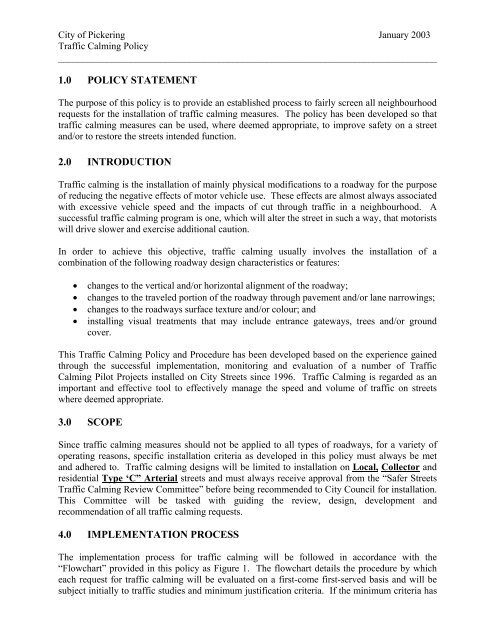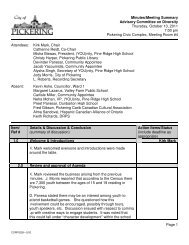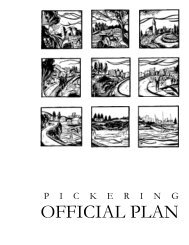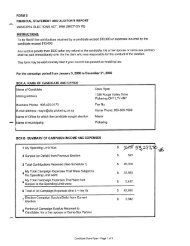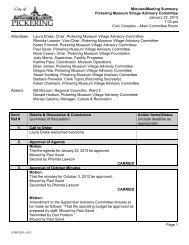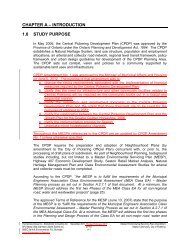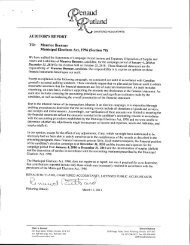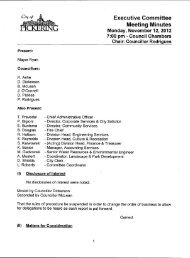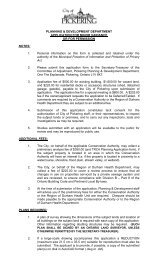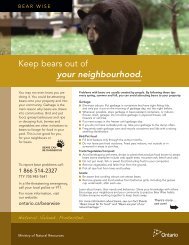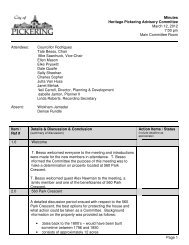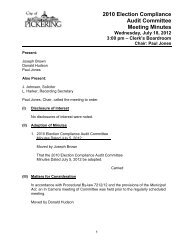foreword - City of Pickering
foreword - City of Pickering
foreword - City of Pickering
You also want an ePaper? Increase the reach of your titles
YUMPU automatically turns print PDFs into web optimized ePapers that Google loves.
<strong>City</strong> <strong>of</strong> <strong>Pickering</strong> January 2003<br />
Traffic Calming Policy<br />
______________________________________________________________________________<br />
1.0 POLICY STATEMENT<br />
The purpose <strong>of</strong> this policy is to provide an established process to fairly screen all neighbourhood<br />
requests for the installation <strong>of</strong> traffic calming measures. The policy has been developed so that<br />
traffic calming measures can be used, where deemed appropriate, to improve safety on a street<br />
and/or to restore the streets intended function.<br />
2.0 INTRODUCTION<br />
Traffic calming is the installation <strong>of</strong> mainly physical modifications to a roadway for the purpose<br />
<strong>of</strong> reducing the negative effects <strong>of</strong> motor vehicle use. These effects are almost always associated<br />
with excessive vehicle speed and the impacts <strong>of</strong> cut through traffic in a neighbourhood. A<br />
successful traffic calming program is one, which will alter the street in such a way, that motorists<br />
will drive slower and exercise additional caution.<br />
In order to achieve this objective, traffic calming usually involves the installation <strong>of</strong> a<br />
combination <strong>of</strong> the following roadway design characteristics or features:<br />
<br />
<br />
<br />
<br />
changes to the vertical and/or horizontal alignment <strong>of</strong> the roadway;<br />
changes to the traveled portion <strong>of</strong> the roadway through pavement and/or lane narrowings;<br />
changes to the roadways surface texture and/or colour; and<br />
installing visual treatments that may include entrance gateways, trees and/or ground<br />
cover.<br />
This Traffic Calming Policy and Procedure has been developed based on the experience gained<br />
through the successful implementation, monitoring and evaluation <strong>of</strong> a number <strong>of</strong> Traffic<br />
Calming Pilot Projects installed on <strong>City</strong> Streets since 1996. Traffic Calming is regarded as an<br />
important and effective tool to effectively manage the speed and volume <strong>of</strong> traffic on streets<br />
where deemed appropriate.<br />
3.0 SCOPE<br />
Since traffic calming measures should not be applied to all types <strong>of</strong> roadways, for a variety <strong>of</strong><br />
operating reasons, specific installation criteria as developed in this policy must always be met<br />
and adhered to. Traffic calming designs will be limited to installation on Local, Collector and<br />
residential Type ‘C” Arterial streets and must always receive approval from the “Safer Streets<br />
Traffic Calming Review Committee” before being recommended to <strong>City</strong> Council for installation.<br />
This Committee will be tasked with guiding the review, design, development and<br />
recommendation <strong>of</strong> all traffic calming requests.<br />
4.0 IMPLEMENTATION PROCESS<br />
The implementation process for traffic calming will be followed in accordance with the<br />
“Flowchart” provided in this policy as Figure 1. The flowchart details the procedure by which<br />
each request for traffic calming will be evaluated on a first-come first-served basis and will be<br />
subject initially to traffic studies and minimum justification criteria. If the minimum criteria has


